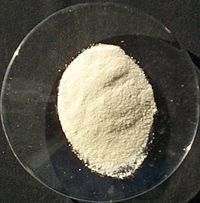
Photo from wikipedia
Abstract Cerium oxide (CeO2) prepared by annealing of carbonate precursor was tested for degradation of paraoxon methyl (PO) and the relationships between its properties (specific surface area, crystallite size, number… Click to show full abstract
Abstract Cerium oxide (CeO2) prepared by annealing of carbonate precursor was tested for degradation of paraoxon methyl (PO) and the relationships between its properties (specific surface area, crystallite size, number of hydroxyl groups) and the catalytic activity were investigated. Lewis and Bronsted acidity surface sites were identified by adsorption of specific probe molecules (pyridine, acetonitrile, and acetone) using Fourier-transform infrared spectroscopy (FTIR). The abundance of Lewis type sites was recognized while Bronsted type sites were present to a lesser extent. The highest catalytic activity had the sample annealed at 500 °C that was highly crystalline, but the sample retained high surface area and a suitable number of surface hydroxyl groups established to be in the range 0.165–0.190 mmol g−1. Furthermore, the annealing has a negligible effect on the point of zero charge (PZC) but significantly affected the Brunauer-Emmett-Teller surface area (BET), crystallite size and number of surface hydroxyl groups that significantly affected also the degradation efficiency. Nevertheless, it was found that the amount of residual carbonate species on the CeO2 surface may also have a crucial influence on its catalytic activity.
Journal Title: Journal of environmental chemical engineering
Year Published: 2021
Link to full text (if available)
Share on Social Media: Sign Up to like & get
recommendations!